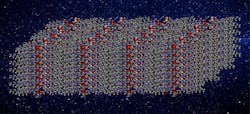International team develops biomimetic membrane for desalinating seawater
FRANCE -- The treatment of seawater, including its large-scale desalination, is a major challenge for our society. Reverse osmosis is one of the most widely used techniques for the desalination of water. Some of the membranes currently used are artificial channels of water inserted into lipid layers. But their large-scale performance is not satisfactory under real osmotic pressure and salinity conditions.
An international team, involving researchers from KAUST (Saudi Arabia) and Politehnico di Torino (Italy) and coordinated by scientists from the Institut Européen des Membranes (CNRS/ENSC Montpellier/University of Montpellier), has developed a hybrid strategy, which consists of combining a polyamide matrix and artificial water channels into a single structure.
Their membranes, which take the form of a sponge superstructure, have been tested under industrial conditions and outperform conventional membranes. Their flow is 75% higher than that observed with current industrial membranes and they require about 12% less energy for desalination.
Their work is patented and was published on November 9, 2020 in Nature Nanotechnology.
